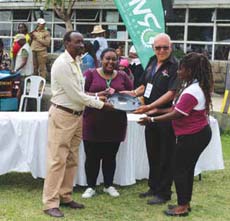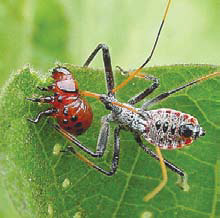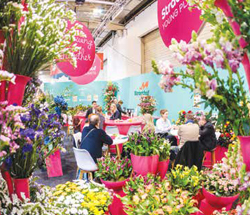 Horticultural production is concentrated in regions such as the Great Rift Valley, Lake Naivasha, Mount Kenya, and Nairobi. The total horticultural area spans approximately 496,062 hectares, yielding 7.9 million metric tonnes, with roses dominating flower exports. For more than two decades, the Naivasha Horticultural Fair has been a hub of innovation, knowledge-sharing, and business networking for those involved in the cultivation of plants, herbs, flowers, fruits, and vegetables. This annual fair has grown from modest beginnings to a grand spectacle, drawing participants from across the globe to showcase their products, exchange ideas, and explore the latest advancements in the field of horticulture.
Horticultural production is concentrated in regions such as the Great Rift Valley, Lake Naivasha, Mount Kenya, and Nairobi. The total horticultural area spans approximately 496,062 hectares, yielding 7.9 million metric tonnes, with roses dominating flower exports. For more than two decades, the Naivasha Horticultural Fair has been a hub of innovation, knowledge-sharing, and business networking for those involved in the cultivation of plants, herbs, flowers, fruits, and vegetables. This annual fair has grown from modest beginnings to a grand spectacle, drawing participants from across the globe to showcase their products, exchange ideas, and explore the latest advancements in the field of horticulture.
Category: Featured Past Articles
 is a special year for Danziger, celebrating 70 years as a company alongside the celebration of the founder, Ernest Danziger’s 100-year birthday on November 16th.
is a special year for Danziger, celebrating 70 years as a company alongside the celebration of the founder, Ernest Danziger’s 100-year birthday on November 16th.
With enthusiasm for flowers, appreciation for beauty, and everything in between, Ernest and Zehava Danziger founded their company in the early 1950s. At that time, they could not have imagined that in 2023 Danziger would produce and sell more than 750 million plants and cuttings worldwide, adding color and happiness to many places in the world.
In the fast-paced world of business and innovation, few individuals leave a mark as indelible as Ernest Danziger has on the floriculture industry. As we reflect on a century of a life well lived, we celebrate a hard-working and creative leader who is blessed with unwavering optimism. Together with his wife, Zahava Danziger, they have built an enduring legacy with their own hands.
 Marketing flowers to Millennials can be challenging, particularly since they perceive them as traditional and more of a luxury purchase. However, Millennials are the largest generation in the United States, with plenty of spending power. So, how can you increase their interest in buying flowers? Here are eight ways to appeal to their values and lifestyle with your floral marketing.
Marketing flowers to Millennials can be challenging, particularly since they perceive them as traditional and more of a luxury purchase. However, Millennials are the largest generation in the United States, with plenty of spending power. So, how can you increase their interest in buying flowers? Here are eight ways to appeal to their values and lifestyle with your floral marketing.
Share Your Knowledge with Online Content
Because flowers are perceived to be expensive to this group, it’s vital to show the added value of flowers. Create a blog where you provide information about how to care for flowers, tips to make floral arrangements last longer, the meaning behind each flower, DIY guides, and socially conscious information (sustainable products, reduced chemical usage, etc.). This extra knowledge will add perceived value to your flowers and boost customer loyalty. Publishing content regularly is also a great way to move up the search engine rankings!
By Mary Mwende Mbithi

 In the not-so-distant past, packaging was a laborious task, with boxes that were a hassle to assemble and far from eco-friendly. Reusability seemed like a distant dream. However, times have changed, and so has the world of packaging. The Hybrid Flower Box, a groundbreaking innovation from Allpack Industries, is definitely where innovation meets sustainability, and where your business meets success and it’s set to transform the way we think about packaging.
In the not-so-distant past, packaging was a laborious task, with boxes that were a hassle to assemble and far from eco-friendly. Reusability seemed like a distant dream. However, times have changed, and so has the world of packaging. The Hybrid Flower Box, a groundbreaking innovation from Allpack Industries, is definitely where innovation meets sustainability, and where your business meets success and it’s set to transform the way we think about packaging.
It is nothing short of a game-changer and not only is it fully recyclable, leaving a significantly smaller carbon footprint, but it also boasts a remarkable up to 4% reduction in the cost per box. And the savings don’t end there. Thanks to its reduced weight, that accounts for a significant decrease in freight costs.
 In the heart of East Africa, Kenya has emerged as a global hub for flower production, earning the country the moniker “The Flower Basket of the World.” With its diverse climate, rich soil, and skilled workforce, Kenya’s flower industry has become a key driver of the nation’s economy. However, as the industry continues to grow, it faces various challenges, including the need to embrace sustainable practices that are environmentally friendly and economically viable.
In the heart of East Africa, Kenya has emerged as a global hub for flower production, earning the country the moniker “The Flower Basket of the World.” With its diverse climate, rich soil, and skilled workforce, Kenya’s flower industry has become a key driver of the nation’s economy. However, as the industry continues to grow, it faces various challenges, including the need to embrace sustainable practices that are environmentally friendly and economically viable.
One crucial aspect of sustainable flower production in Kenya is the use of biologicals. These are biological agents, such as beneficial microorganisms, insects, and other organisms, which play an essential role in maintaining a healthy and balanced ecosystem in flower farms. Insect monitoring is a critical component of integrated pest management programs, ensuring the accurate identification of pests to implement the appropriate control measures. Utilizing insect traps is one method to assess insect prevalence.
 In floriculture, where growers strive to produce vibrant and healthy plants, plantparasitic nematodes can be formidable adversaries. These microscopic worms infest the roots of plants, causing damage that can lead to reduced yields and plant vitality. To combat this challenge, growers are turning to nature’s tiny warriors: beneficial nematodes.
In floriculture, where growers strive to produce vibrant and healthy plants, plantparasitic nematodes can be formidable adversaries. These microscopic worms infest the roots of plants, causing damage that can lead to reduced yields and plant vitality. To combat this challenge, growers are turning to nature’s tiny warriors: beneficial nematodes.
Understanding Plant-Parasitic Nematodes
Plant-parasitic nematodes are a diverse group of microscopic worms that feed on the roots of various plant species, causing damage that can lead to stunted growth, wilting, and even plant death. They are a significant concern for floriculture as they can affect the quality and marketability of ornamental plants. Nematodeinfested plants not only look unhealthy but also have reduced nutrient uptake, making them more susceptible to other stressors such as diseases and environmental factors.

Reduction
The three R’s are a natural fit. We need to find the carbon footprint of what we are doing. This is the question where sustainability comes in, what is the environmental impact? Today’s market place; the millennials and the generation coming after, choose products based on their impact on the ecosystem. People purchasing today are using different parameters, whether you like it or not. “If you can identity and differentiate, your product from the guy next to you , as environmentally safe and ethically grown as well as meeting all other requirements for sustainability, then you’ll have a better leg to stand on,” Parit emphasized.
A lot of Carbon emissions is packaged per every kilo of flowers every year. This is where Kenya should put efforts to differentiate products and make them more competitive.
“Climate plants and resource-saving production took centre stage”.
 “The joy that IPM ESSEN could finally take place again could be felt in every hall and at every stand”, Oliver P. Kuhrt, CEO of Messe Essen, sums up. The reunion of the green sector turned out to be more international than expected. Over 40,000 trade visitors from more than 100 countries came to Messe Essen to exchange information and to place orders. There was a wide range of products: 1,330 companies from 46 nations presented their innovations and new products in the fields of plants, technology, floristry and garden features from 24 to 27 January. Climate plants, environmentally friendly packaging and peat alternatives were particularly on trend.
“The joy that IPM ESSEN could finally take place again could be felt in every hall and at every stand”, Oliver P. Kuhrt, CEO of Messe Essen, sums up. The reunion of the green sector turned out to be more international than expected. Over 40,000 trade visitors from more than 100 countries came to Messe Essen to exchange information and to place orders. There was a wide range of products: 1,330 companies from 46 nations presented their innovations and new products in the fields of plants, technology, floristry and garden features from 24 to 27 January. Climate plants, environmentally friendly packaging and peat alternatives were particularly on trend.
“The importance of IPM ESSEN for the global green industry remains high even after the pandemic. The internationality of the trade audience is close to the 2020 level. In view of the dynamic market situation of the last few years and the travel restrictions that are still noticeable, this is a great result”, continues the tradeshow CEO Kuhrt. The proportion of trade visitors from abroad was 33 percent (2020: 40). At 66 per cent, the proportion of exhibiting companies from abroad was even four percentage points higher than in 2020. Eva Kähler-Theuerkauf, President of the North Rhine- Westphalia Horticultural Association and Chairwoman of the IPM Advisory Board added: “IPM ESSEN 2023 was a complete success. It was good to meet again in our gardening family. The fair also met with great interest internationally. Anyone who was there neither as an exhibitor nor as a visitor definitely missed out a lot.”
 Leaf yellowing is symptomatic of a variety of problems, most of which can be pigeon-holed into four main categories that is, enviromechanical problems, nutrient deficiencies, pest damage, and disease damage. Its one of the symptoms that can be noted whenever a plant lacks or have had too much of something as it grows. When for example there is excessive fertilizer, irrigation, chemicals and nutrients the leaf tissues turn yellow whereby growth may become stunted. Other symptoms that go together with yellowing include reduced growth, scorched margins, fall of leaves and failure of blooms to open completely.
Leaf yellowing is symptomatic of a variety of problems, most of which can be pigeon-holed into four main categories that is, enviromechanical problems, nutrient deficiencies, pest damage, and disease damage. Its one of the symptoms that can be noted whenever a plant lacks or have had too much of something as it grows. When for example there is excessive fertilizer, irrigation, chemicals and nutrients the leaf tissues turn yellow whereby growth may become stunted. Other symptoms that go together with yellowing include reduced growth, scorched margins, fall of leaves and failure of blooms to open completely.
Enviro- Mechanical Problems
Heat Stress: This problem is brought about by Heat Stress where it is frequently noticed after wet and relatively cool weather, especially when the transition from spring to summer temperatures is sudden. Exposure of this new growth to direct sun can cause scorching of leaf.
This can be treated by applying anti-transpirants/anti-desiccants. Plant roses where they will receive protection from the hot sun and Mulch heavily around root zones to stabilize soil and near-surface air temperatures.
The modern crop protection market not only makes big demands of active substances and their formulation: It also presents significant challenges in items of packaging design. The materials that are used must protect the product from the effects of external factors; but at the same time, they must also protect the user, and the environment, from the product itself. Floriculture Magazine spoke to an expert.
What are the challenges that packaging for crop protection must meet?
Crop protection products are used seasonally, so they must sometimes be stored for prolonged periods, and the packaging material must not change during this time. On the one hand, it must protect the environment and the user from the crop protection product, so it is essential that there are no leaks (for example of solvents). On the other hand, the crop protection product must retain its quality over long periods of storage, in spite of the various environmental factors that could degrade it, such as light, temperature and moisture.
